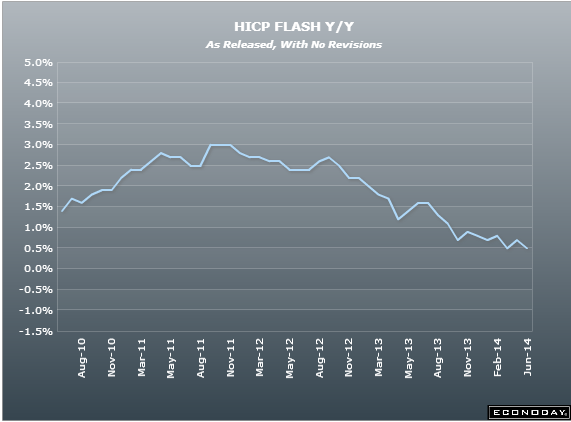Are negative interest rates the answer?
Stock stocks are soaring to fresh record highs in the U.S. following a decision by the European Central Bank to cut one of its key interest rates so low it's in negative territory (minus 0.1 percent) -- challenging the way we think about deposits. Instead of the ECB paying commercial banks to hold cash in its vaults, commercial banks will now pay ECB for holding their deposits.
Why do this?
Because the ECB is trying to remedy a steady drop in economic activity, dangerously low inflation (and a rising risk of deflation, or falling prices) and moribund bank lending. By raising the cost for banks to merely sit on idle cash, policymakers are trying to encourage them to lend it out instead. (It should be noted that many investors expected more -- including outright bond-buying stimulus, or quantitative easing -- and the moves in the currency market, where the euro gained value contrary to the ECB's strategy, reflect some disappointment here.)
But will it work?
One thing's for sure: Action was needed.
Since ECB President Mario Draghi's famous "whatever it takes" commitment back in 2012, so-called "verbal easing" -- or the threat of announcing new stimulus -- has been enough to put an end to the eurozone debt crisis, pushing down bond yields in countries like Spain. It even allowed Greece to return to the bond market despite chatter of requiring another $10 billion bailout package as its unemployment rate remains cripplingly high near 27 percent.
A strong euro has helped, attracting investment capital into Europe's bond markets. While this has pushed down borrowing costs, it has slowly crushed export competitiveness and thus, economic growth, by increasing the cost of Europe's exports in foreign markets. Credit creation has waned. And now, inflation has dropped to such an extent that deflation has become a real concern.
The ECB realized that the benefits of a strong euro have fully played out. It was time for a change.
Recent data has borne this out. GDP growth slowed to a meager 0.2 percent rate in the first quarter. Household spending grew just 0.1 percent. Producer prices are already in deflationary territory, dropping at a -1.2 percent annual rate. And the composite PMI economic activity index for May was revised down to 53.5 from 53.9.
The overall eurozone inflation rate, shown in the chart above, tells the story. Low inflation in an environment of high indebtedness like Europe's is a recipe for a debt-deflation nightmare. Just ask the Japanese. It causes the real cost of debt to rise, forcing governments, households and businesses to reduce spending.
Why did the ECB wait so long to take this action, after dithering for months about the specter of new stimulus?
That subject could fill an entire column on its own. Basically, it boils down to four points:
One is that the German Bundesbank has a cultural disinclination for the kind of money-printing stimulus the U.S. Federal Reserve and the Bank of Japan have been so eager for.
Second, a weaker euro was one of the factors of the eurozone crisis in the first place, so actively trying to weaken the currency again could bring back that problem.
Three, there's reason to believe that outright quantitative easing -- or the "unsterilized" purchases of government bonds by the ECB that many in the market were looking for -- would be illegal according to the ECB's charter.
And finally, Draghi essentially bluffed the market and scared away the investors betting on the eurozone's failure in 2012. But like any good poker player, he's reluctant to show his hand and reveal exactly what he meant by "whatever it takes." There have been veiled references to what's been dubbed "Outright Monetary Transactions" but no firm details of this plan -- which vaguely resembles the Fed's open-ended QE3 programs -- have been released aside from a short statement back in September 2012.
So, will today's actions work?
Despite the rally in U.S. stocks, the ECB isn't exactly getting the reaction it wanted. After a dramatic initial drop, the euro rallied to move back over its 200-day moving average, as shown in the chart above. That's not what Draghi wanted to see.
The reversal stems from disappointment that the ECB didn't announce any sizable bond-buying stimulus. Draghi tried to address this disappointment in his press conference today, warning that "we aren't finished here" and the central bank would unleash more stimulus if necessary.
While negative interest rates seem like an extreme step, Denmark tried it two years ago, with mixed results.
In the end, with U.S. markets rallying on the euro's rise, the ECB's work isn't done yet.
For investors, a big beneficiary of today's events was precious metals, with gold and silver enjoying some buying interest for the first time in weeks as inflation expectations increase. It'll be worth keeping an eye on this sector in the days to come to see if this buying evolves into a full-strength uptrend.


